In Deep

he sea abounds with show-stealers. Dolphins burst like rockets through the wave crests. An octopus’s lyrical suctioned army of arms transfixes. The blue whale, Balaenoptera musculus , weighing up to 330,000 pounds, sends its whistles, moans, and calls through water for thousands of miles. And when the giant marine mammal gives birth, mothers nimbly nose newborns to the ocean’s surface for their first breaths of precious air.
Consider, too, the ruthless stealth of the lowly mantis shrimp. This 6-inch ocean citizen releases a jaw punch to its prey with a strike force so ferocious it can delimb a crab. The blow, measured at 15,000 newtons, equals the acceleration of a .22-caliber bullet.
For Swarthmoreans at work in the world’s (now five) named oceans, the water’s inhabitants — both behemoth and near invisible — captivate.
It wasn’t only the mantis shrimp’s power that first fascinated Rachel Crane ’13. It was also the crustacean’s technique.
“I left Swarthmore with a deep love of invertebrates, biomechanics, and marine systems,” says Crane, who studied “beautiful lugworms” with Professor Rachel Merz at the College before graduating to the mantis shrimp as a lab manager at Duke University.
“They’re really interesting, with the most amazing mouth parts. Their jaw is like a bullet in the muzzle of a gun,” she says. “It has a super-fast, amazing strike.”
When Crane noticed how masterful mantis shrimp were at cracking open shells, she began to wonder if they approached each prey differently.
he sea abounds with show-stealers. Dolphins burst like rockets through the wave crests. An octopus’s lyrical suctioned army of arms transfixes. The blue whale, Balaenoptera musculus , weighing up to 330,000 pounds, sends its whistles, moans, and calls through water for thousands of miles. And when the giant marine mammal gives birth, mothers nimbly nose newborns to the ocean’s surface for their first breaths of precious air.
Consider, too, the ruthless stealth of the lowly mantis shrimp. This 6-inch ocean citizen releases a jaw punch to its prey with a strike force so ferocious it can delimb a crab. The blow, measured at 15,000 newtons, equals the acceleration of a .22-caliber bullet.
For Swarthmoreans at work in the world’s (now five) named oceans, the water’s inhabitants — both behemoth and near invisible — captivate.
It wasn’t only the mantis shrimp’s power that first fascinated Rachel Crane ’13. It was also the crustacean’s technique.
“I left Swarthmore with a deep love of invertebrates, biomechanics, and marine systems,” says Crane, who studied “beautiful lugworms” with Professor Rachel Merz at the College before graduating to the mantis shrimp as a lab manager at Duke University.
“They’re really interesting, with the most amazing mouth parts. Their jaw is like a bullet in the muzzle of a gun,” she says. “It has a super-fast, amazing strike.”
When Crane noticed how masterful mantis shrimp were at cracking open shells, she began to wonder if they approached each prey differently.
By watching the charismatic predator’s feeding behavior, Crane started to think about what it took to withstand the assault. “I pivoted,” she says. “I got interested in mollusk shells, thinking of the accumulated damage of the mussels that live on the rocky coast where waves bombard them. If a shell survives one encounter, how does it repair damage?”
For Crane, who earned her Ph.D. at Stanford University’s Hopkins Marine Station, invertebrates and bivalves all have an “unseen charisma.”
“They’re extremely important and cover huge expanses of the California coast,” she says. “The mussels’ beds provide a home to diverse life, and the bed provides protection for these animals.” The animals experience massive temperature fluctuations, can face thermal stress from sunlight at the peak heat of the day, and are bombarded by waves and boulders that can crush them.
For the past six years, Crane has been studying the mechanics of what makes an effective shell armor.
“The shell is constrained by its evolutionary past,” says Crane. “And evolution is acting across deep time. The hurdle comes in understanding what is still effective” for the shell, she says.
As new threats emerge, Crane asks: Do the shells change in ways that make them stronger?
“Mussels have all different kinds of predators: Otters and crabs will hammer on shells, birds who will pick them up and drop them.”
If that’s not enough, meet the drilling predators. “Octopuses and snails drill holes through the shell to eat the mussel,” says Crane. Starfish are another menace — Crane often witnesses the “extended fight” that occurs when a starfish eats a mussel. “The starfish will need to retreat with the tide, with its hunched posture wrapped around the mussel,” she says.
The coastal environments where Crane works are “really accessible as opposed to the deep ocean, but there is really amazing stuff to see.”
The ocean holds mysterious life and “things that push your understanding of what an animal is,” says Crane. “But in the end, it is still biology — not a totally different dimension. We can answer fundamental questions from a biological perspective.
“There are a lot of questions that can be answered by looking to the ocean, but those answers often loop back to us.”
Humans have the knowledge and technology to make good choices, says Merz, the Walter Kemp Professor Emerita in the Natural Sciences. “But political and societal pressures, the lack of education, and pressures from the burgeoning human population can all lead to bad choices for ocean health.”
One point of light, “is the capacity of marine species and ecosystems to recover if given relief from what is limiting them,” says Merz.
If fishing pressure is relieved, she says, species can rebound.
“Ecosystems have resilience if disruptors — pollution, overfishing, development — are halted,” she says. “We live on this small, finite planet hurtling through space, and against great odds life has and is evolving here. That process has produced extraordinary beauty visible in the intricacies and the whole of every organism and ecosystem,” says Merz. “The living world feels vast, but, like us, it is mortal.”
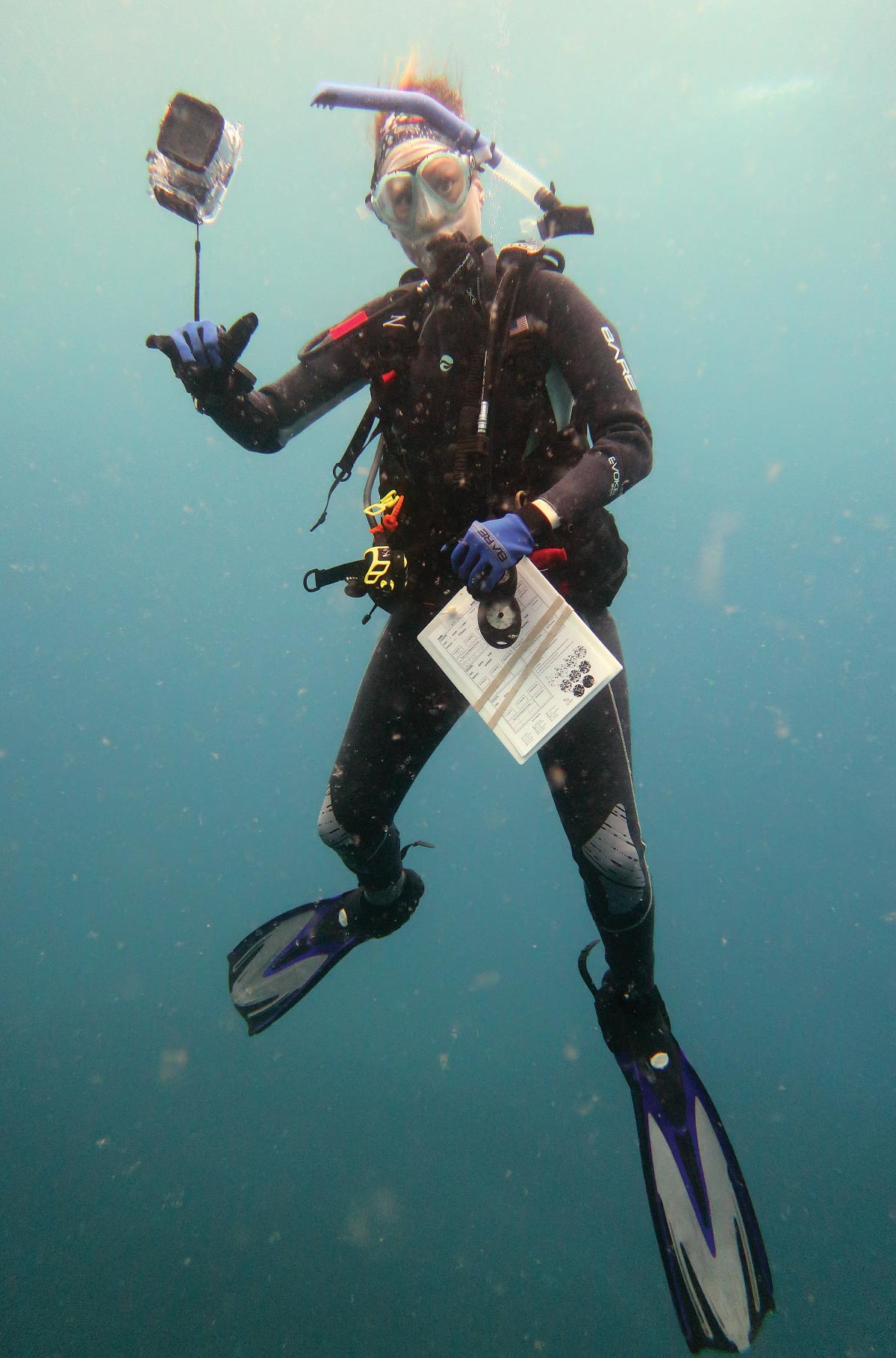
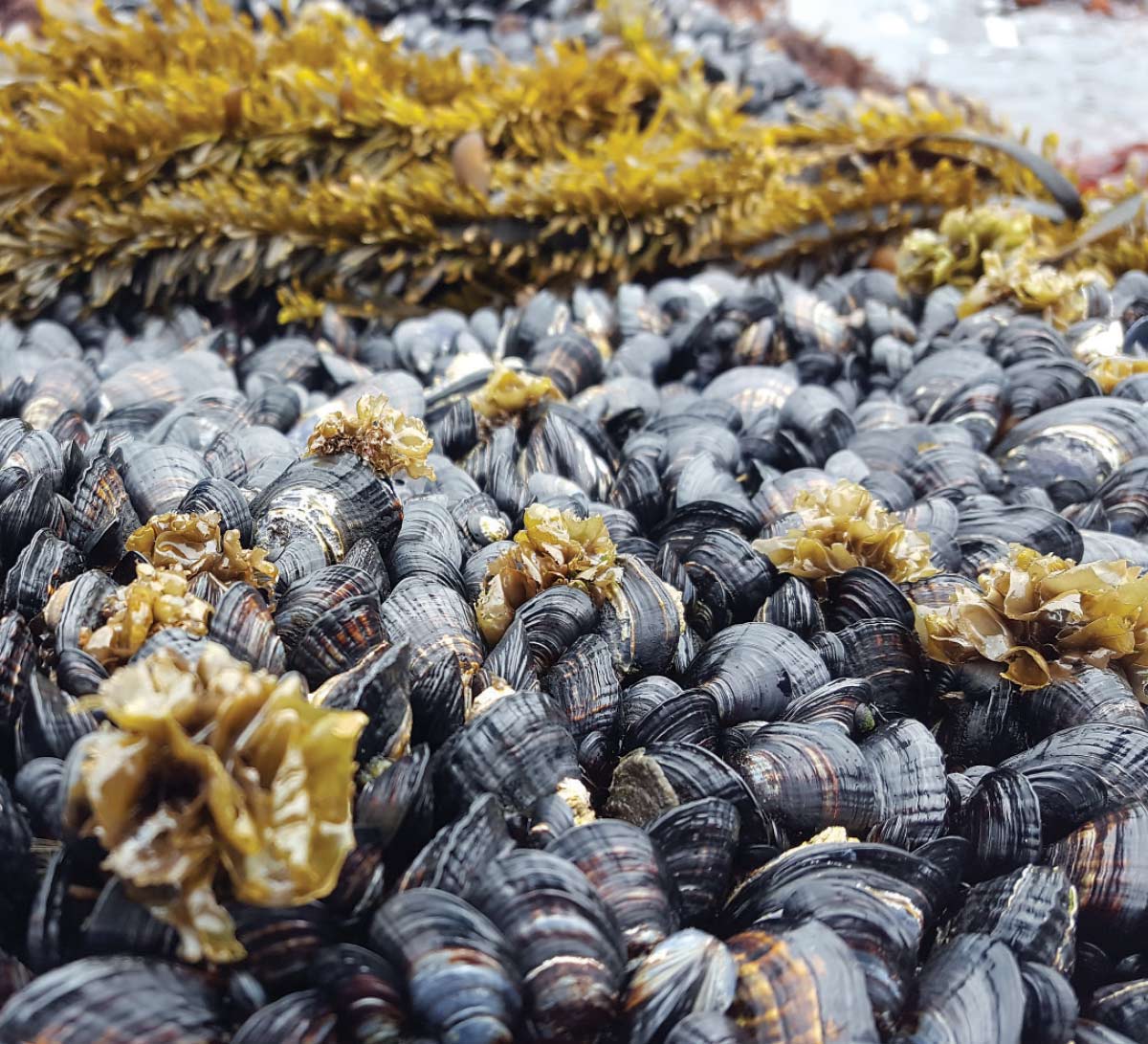

Bumping Into Strangers in the Dark
“When you dive at night, all you can see is the small area illuminated by your flashlight,” says Ylitalo-Ward, who works in Hawaii for the Division of Aquatic Resources, a branch of the state Department of Land and Natural Resources. As part of a team monitoring fresh and saltwater in each of the main Hawaiian Islands, most of her work is below the surface.
“Suddenly, I turned and there was a huge animal right next to me. It turned out to be a sleeping turtle that was equally startled,” she says. “I think we were both relieved to see one another instead of a large tiger shark.
“Really, every day in the water is a treat, and I see something incredible every time I dive. I feel very lucky to be able to do this job.”
Ylitalo-Ward, who studied octopuses for her dissertation research at the University of Hawaii at Manoa, agrees with Crane that science requires patience. “It can be very hard to find octopuses in the wild, even with a trained eye, so it is important to spend time looking for little hints in the environment,” she says. “They taught me a lot about taking time to really look at things.”
The species she studied, Octopus oliveri, lives only 12–16 months. “It was a reminder to try to make the most of each moment,” says Ylitalo-Ward. “They capitalize on the time they have on this planet: searching for food, exploring the reef, finding mates, having thousands of babies. Their capacity to solve puzzles and escape their enclosures was remarkable. They never stopped exploring, which is something I hope to emulate.”
Working primarily in Kauai, Ylitalo-Ward scuba-dives on the reefs, collecting data to characterize the health of the fish populations and benthic substrate. “We have a small team dedicated to working with the local community to conserve and restore the unique ecosystems of Kauai,” she says.
“This designation allows for strong community involvement and natural practices to guide management decisions,” she says. “Since its designation, there have been significant positive trends in fish populations within the managed area.”
The chance to study coral reef ecosystems draws researchers who help to initiate responsible management decisions. Ylitalo-Ward collaborates with them to help identify trends.
One trend emerging in Kauai is an increase in algae growth during times with high temperatures and slow-moving water.
“We’re also seeing increased algae growth and changes in nearshore community structure after strong rain events, when there are high amounts of runoff coming from the watershed,” she says. “There are some coral species that are more tolerant to temperature change, and those may start to be the dominant colonies we will see on reefs moving forward. It doesn’t mean the reefs will be gone; it just means they will be different.”
Another key to reef resilience is fish populations, says Ylitalo-Ward. “We can have a positive impact by minimizing the amount of herbivore species removed from the ecosystem. Those herbivores help remove algae from corals, which in turn can help the corals recover from bleaching events. We have to focus on what we can do to help, rather than feel defeated by the things we have already lost.”
From November to April, humpback whales come to Hawaii to have their calves and mate. Researchers arrive to tag the whale populations and study their migratory behavior. Other whale species can also be spotted around Hawaii, Ylitalo-Ward says, including false killer whales, melon-headed whales, short-finned pilot whales, and sperm whales.
“I’ve often been out on boats to get to our dive locations and had humpbacks breaching around us,” she says. “It’s a pretty magical feeling to be driving out to a site and suddenly having a gigantic humpback whale surface right next to the boat. We always try to keep our distance and give them their space, but sometimes they come right up next to you without any warning.”
The constant song of the whales accompanies the dives.
“You can hear the songs of the whales so loudly, it sounds like they must be right on top of you,” says Ylitalo-Ward. “Their songs are complex and oddly melodious — a perfect soundtrack to data collection.”
Ancient Links in Our Evolutionary Story: Sea Squirts Hold Important Secrets
But because sea squirts (also called tunicates) tend to be self-sterile, “they need to squirt next to another individual in order to reproduce.”
Davidson says the famous geneticist T. H. Morgan was intrigued by this self-sterility mechanism, “realizing that it must involve some sort of molecular or genetic basis for eggs and sperm to recognize self from non-self — like our immune cells do.”
And as if one more extraordinary trait were necessary — sea squirts also “eat” their own brains.
Sort of.
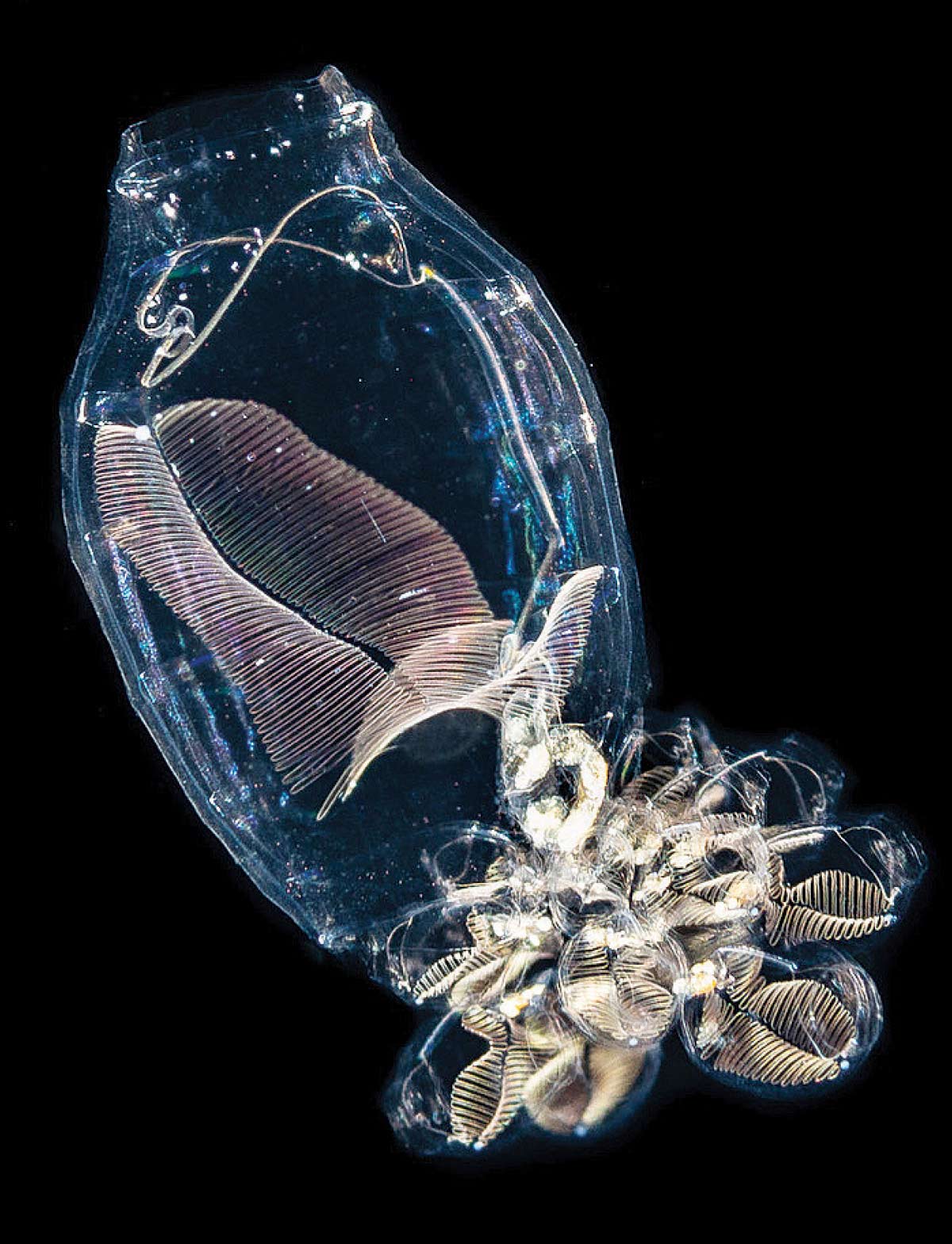
It is during this transition, says Davidson, that sea squirts “reabsorb portions of the larval brain, specialized for swimming, and remodel the remainder to generate a new, juvenile-specific organ, presumably specialized for feeding and reproducing.”
The National Science Foundation (NSF) recently awarded a grant to Davidson and his collaborators, Danelle Devenport, associate professor of molecular biology at Princeton University, and Christina Cota, assistant professor of biology at Colby College, focused on how signal receptors are moved around in dividing cells, including mammalian cells.
“Although sea squirts are close cousins to vertebrates, including humans, sea squirt embryos have extraordinarily low cell numbers,” explains Davidson. “The embryonic stage we study only has 200 cells while a vertebrate embryo at this same stage would have roughly 10,000 cells.”
This allows Davidson and his colleagues to study how individual cells “communicate with their neighbors in an intact embryo at very high resolution.”
His work with sea squirts is helping to discern some fundamental rules of how cells communicate as they divide, and ultimately how errors in this process may contribute to human diseases, including cancer.
“Because these cells communicate through chemical signals that are extremely similar to the signals exchanged between human and other animal cells, we can leverage our findings to help us address questions relevant to human health along with the development of embryos,” says Davidson.
In order to receive these signals, cells must produce an antenna-like protein called a signal receptor.
“We’ve found that embryonic cells ‘shut down’ these antenna-like receptors when they are dividing” he says, “and this appears like it might be a general feature of dividing cells that was never noticed before.”
Davidson explores how receptors are moved around in dividing cells, including mammalian cells.
“This is an urgent question,” he says, “because cancer is primarily caused by misregulation of cell signaling, and so understanding the interplay between division and signaling is crucial for understanding the origins of cancerous cell behaviors.”
The NSF also recently awarded Davidson an Early-Concept Grant for Exploratory Research (EAGER) to work with collaborators Marc Fischer and Joe Ryan at the Skidaway and Whitney marine stations to investigate a fascinating and poorly characterized group of sea squirts called doliolids.
“Individual doliolids go through a very complex life history in which they change body plans four times,” says Davidson. “They start off as a large nurse that grows a long tail on which two different body types grow in grape-like clusters called zooids. Some of these zooids are specialized for feeding and some for reproduction. The reproductive zooids detach and grow their own tails containing clusters of another distinct reproductive body type.”
This last body type makes both eggs and sperm, he says, squirting them out to make a new generation of nurses. “What’s really fascinating to me is the capacity for a single genome to encode four different bodies,” Davidson says. “That’s what I’m hoping to investigate — how does a single set of genes instruct the formation of not just one body but four distinct bodies.”
“Along with being incredibly beautiful, almost like an art piece in their construction,” says Davidson, doliolids are also important ecologically and evolutionarily. “They are especially good at filter feeding and they convert what is unavailable into available nutrients,” he says.
When sea squirts die, or excrete, they produce marine snow that drifts down and provides essential nutrients in deeper waters.
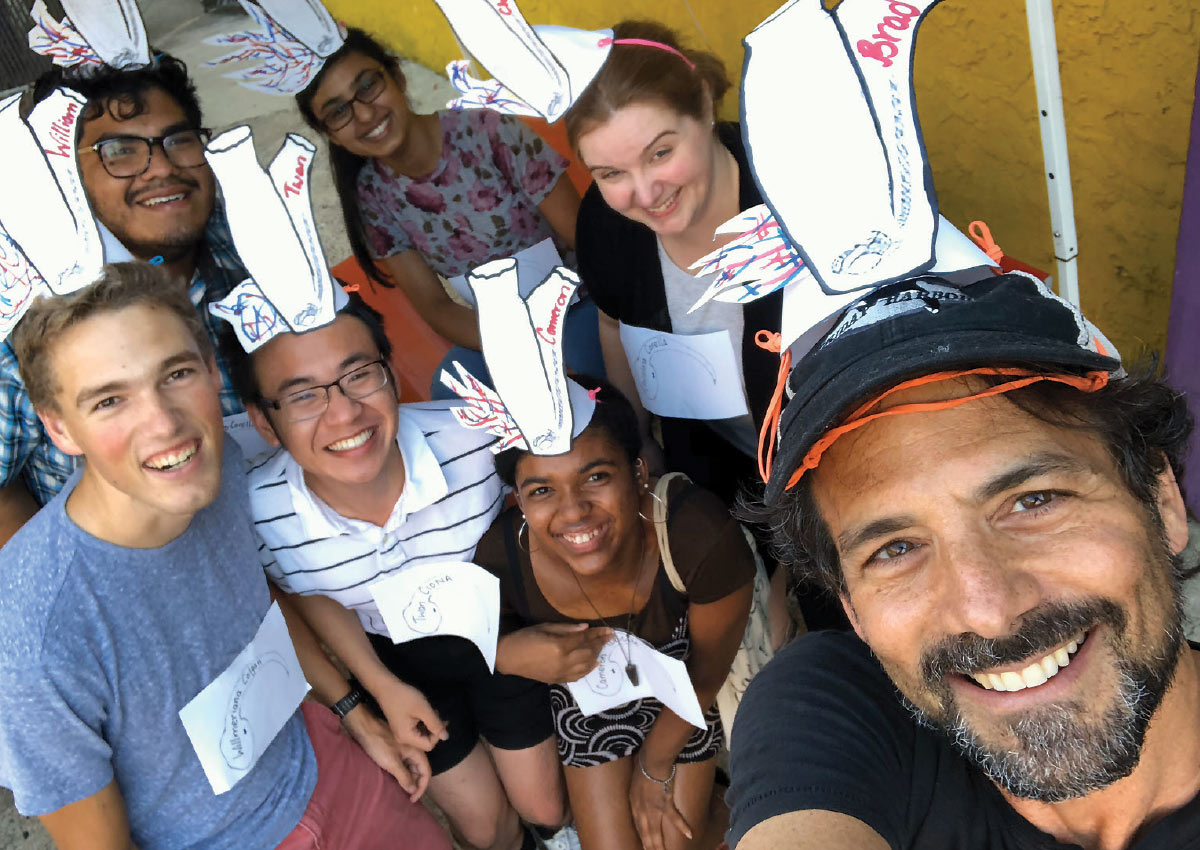
As he continues to witness the changes to a range of marine life where the sea squirt lives, Davidson is deeply concerned.
“I’m not optimistic about the health of the environment of the animals that I study,” he says. “With warmer temperatures, some animals are going to thrive, but overall, it’s clear that diversity is going way down.”
At the University of Washington’s Friday Harbor Laboratories where Davidson has spent time for his research, there has been a “gigantic decrease in diversity.”
“I would say it’s unprecedented,” he says. “In the 10 years I have been collecting, the marine organisms are crashing. It’s just flat instead of rich and diverse.”
Focusing on his role as a scientist and on the role of his students has helped him cope with understanding the loss.
“What I tell students is that diversity is much richer and more fragile than we realize and that we have a mission to document this diversity before it is lost,” says Davidson. “We can direct our efforts positively to really understand what we are losing in terms of species and hopefully find ways to preserve what is left, including the often overlooked sea squirts.”
He hopes others will recognize the critical importance of the sea squirt.
“Each species of sea squirt is the end point of millions of years of evolution,” says Davidson. “When you lose these things, you’re losing something that can never be regained. You’re losing a story that took millions of years to tell and that no one will ever hear.”
But there are also reasons to remain hopeful.
“There is time for us to preserve what is left,” says Davidson. “If we give it a chance, life comes roaring back. Marine organisms are unstoppable, they will find a way to thrive. All we need to do is open the door and they will come pouring through.
“That’s the hope — that life finds a way,” he says. “All these organisms are incredibly resilient if they are just given the chance.”
The World Below the Brine
The world below the brine,
Forests at the bottom of the sea, the branches and leaves,
Sea-lettuce, vast lichens, strange flowers and seeds, the thick tangle, openings, and pink turf,
Different colors, pale gray and green, purple, white, and gold, the play of light through the water,
Dumb swimmers there among the rocks, coral, gluten, grass, rushes, and the aliment of the swimmers,
Sluggish existences grazing there suspended, or slowly crawling close to the bottom,
The sperm-whale at the surface blowing air and spray, or disporting with his flukes,
The leaden-eyed shark, the walrus, the turtle, the hairy sea-leopard, and the sting-ray,
Passions there, wars, pursuits, tribes, sight in those ocean-depths, breathing that thick-breathing air, as so many do,
The change thence to the sight here, and to the subtle air breathed by beings like us who walk this sphere,
The change onward from ours to that of beings who walk other spheres.
Starting with Love
“All of the religions consider nature in balance with itself a divine gift that we humans are to love and steward,” he says. “We are fundamentally aquatic creatures and we come up for air, but we yearn to get back to water. In this model, the world’s oceans, rivers, and wetlands are the circulatory system of Mother Earth; caring for this flow of nutrients and waste is a way of caring for God’s body.”
Indeed, in primordial cultures, all beings have personhood, says Wallace, whose book When God Was a Bird: Christianity, Animism, and the Re-Enchantment of the World (Fordham University Press, 2018) was awarded the 2019 Nautilus Gold Award for best book in Western religious thought.
“There are the tree people, the bear people, the whale people … only some of whom are human beings,” he says. “Whales are especially fascinating. In the Bible, they are symbols of the mystery and beauty of wild nature. Today, we know how similar we are to whales. Like us, they have long lifespans and enjoy deep emotional lives defined by their keen intelligence and rich communication skills.”
According to Indigenous religions, “whales are people just like us,” says Wallace, and it’s amazing what other beings can do when we sense the connection. “We start to think we are part of the same family, and develop an emotional connection and care about their habitat,” he says. “We start with love and then we start to feel a connection to nature. For me, much of this begins in the Crum Woods, and then we want to care about these places.”
Poets, too, often use the sea and its inhabitants as a muse. In Walt Whitman’s “The World Below the Brine,” the worlds of water and land merge, says Peter Schmidt, the William R. Kenan Jr. Professor of English Literature. In this climactic line, “The change onward from ours to that of beings” in other “spheres” Schmidt says, “Whitman asks us to imagine what things might change in us when our minds are able to inhabit (or as least imagine we experience) not just other species but environments, like moving from land to sea.”
In the poem’s final two lines, Schmidt says, Whitman wants the reader “to take another leap, from “our” world, the Earth, to different planets or solar systems. Whitman was convinced that there were many other worlds in the universe beyond our own solar system.”
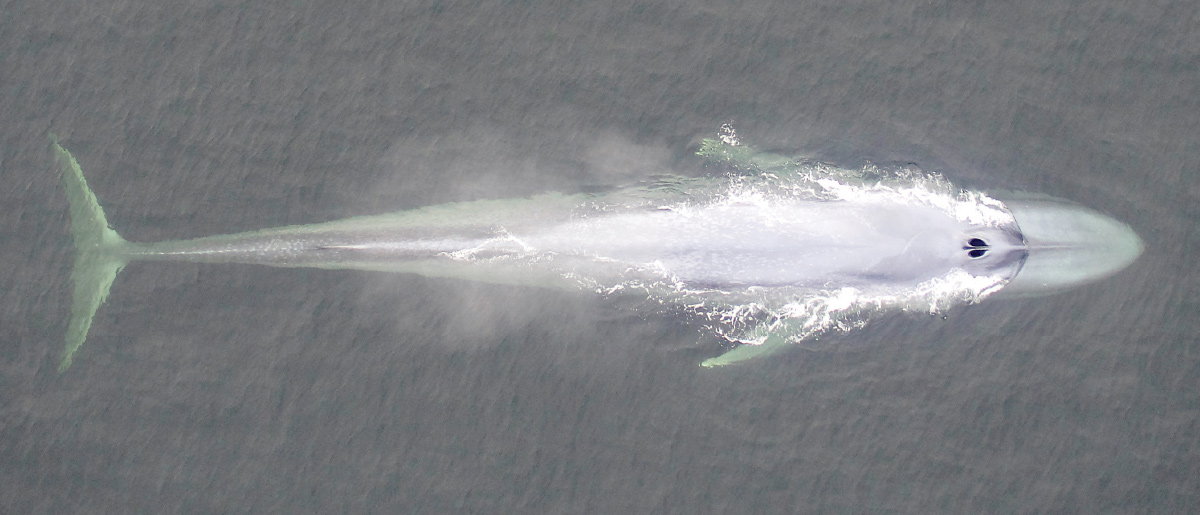
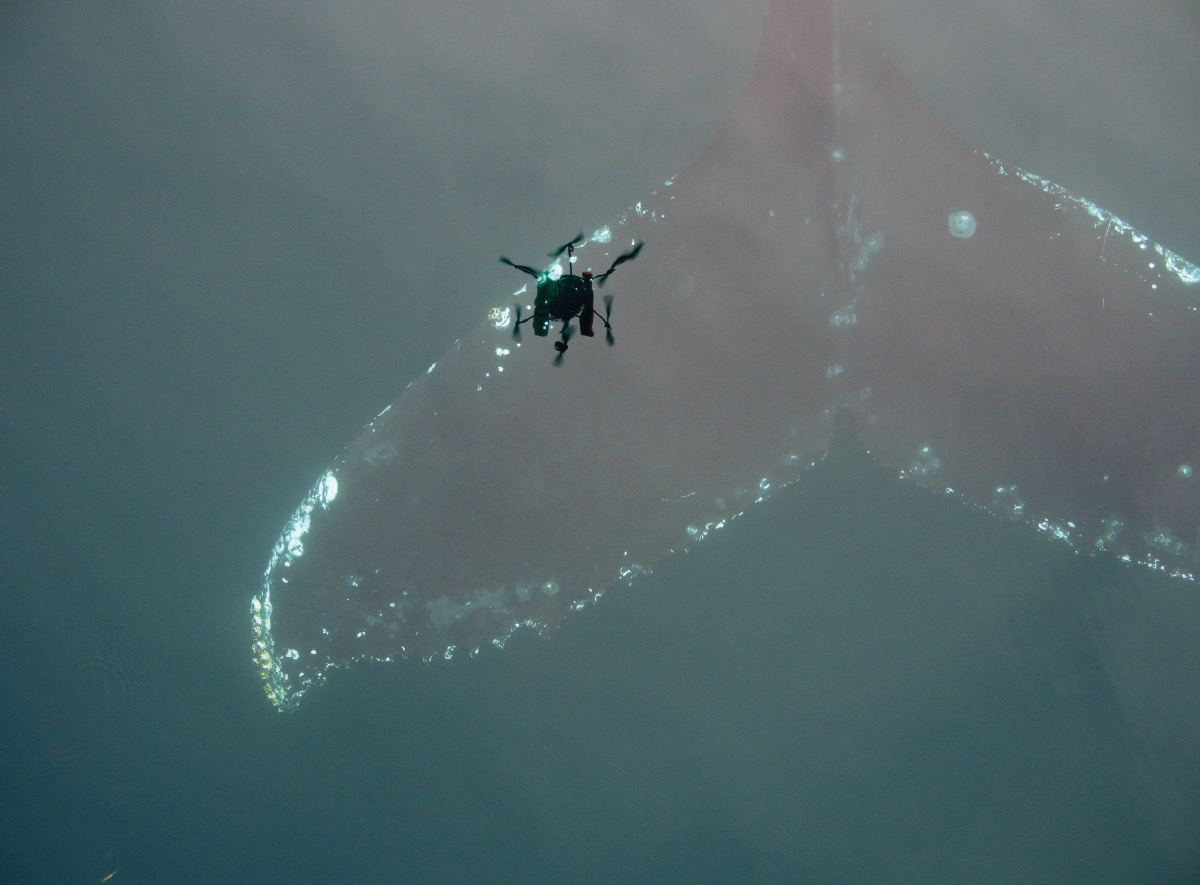

Lost Then Found
“I was a bit lost because I didn’t know what I wanted to do specifically,” says Perkins-Taylor, a Swarthmore native who graduated with a major in biology and a minor in environmental studies.
Then came an extraordinary opportunity to research whales in the wild using drone technology to measure their body movements, behavior, and migration patterns.
“My experience being in the field was genuinely life-changing,” says Perkins-Taylor, who collaborated with Visiting Assistant Professor of Biology Matthew Leslie. “Everything changed for me when I got to observe the humpback whales breach every day and collect data on them using both a drone and a regular DSLR camera.”
“Being exposed to all aspects of the research process and getting to practice them closely with a professor is something that many undergraduate students do not have the opportunity to do,” he adds.
“But I, fortunately enough, did.”
Working with Leslie’s colleagues at Panacetacea, a research, education, and conservation group in Panama, Perkins-Taylor would help to direct Leslie to position the drone from aboard a ship in the Gulf of Chiriquí. That allowed Leslie to monitor the instrument panels and watch the live digital feed.
“Once we identified humpback whales that were behaving in a way conducive to being photographed by the drone, Professor Leslie and I would quickly equip the drone with its propellers and camera,” he says.
To launch the delicate equipment, Perkins-Taylor stood in the ship’s bow in safety gear holding the drone above his head. Then he and Leslie would review a preflight checklist before launching the custom-built drone steadily up into the air.
When the drone flight was complete, Perkins-Taylor would perch in the bow of the ship again and catch the drone as Leslie slowly guided it into his hands. “This is easier said than done because conditions were not always ideal for catching the drone between the wind and the waves,” he says. Kevlar gloves, climbing helmets, and eye protection were critical to the process.
Once safely on shore, Leslie downloaded the photos and data, and Perkins-Taylor calculated the length and width of measurement for each whale.
“Drone technology will have — and is already having — a significant impact on marine-mammal research moving forward for a variety of reasons,” says Perkins-Taylor. “In particular, drones offer a new vertical perspective to study animals in a way that has been shown not to disturb them, making this technology appealing for the novelty and ethics of it. Drones are beginning to revolutionize this field, and that is only going to continue in the years to come.”
Before drone technology, Leslie notes, two options existed to measure whales: find dead ones or risk your life in a small, low-flying plane over the sea.
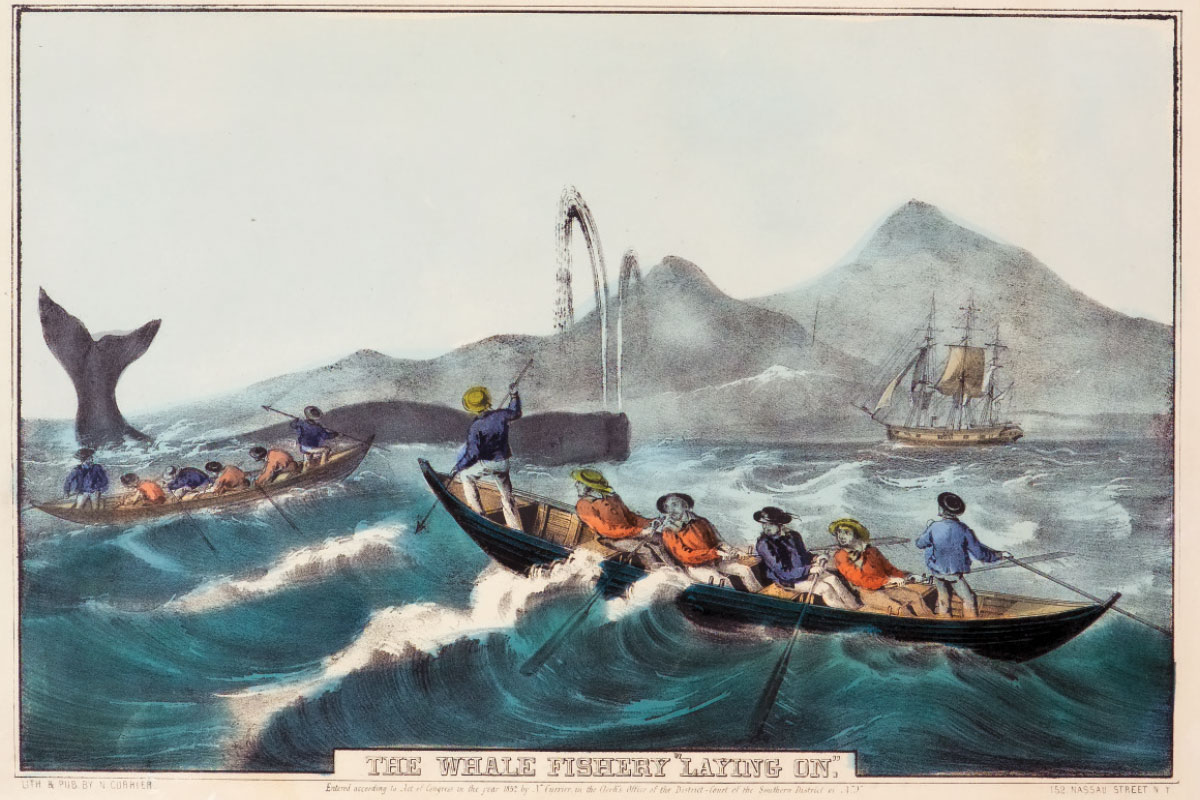
Gift of Lenore B. and Sidney A. Alpert, supplemented with Museum Acquisition Funds. Photography by David Stansbury.
In the 1800s, Americans were chasing whales in the Pacific and Indian oceans, and from the 1920s, Antarctic waters became whaling ground zero for Japanese, Russians, and Norwegians. The constant global movement reflected new demand and a new dynamic that fueled unregulated mass hunting, which resulted in population collapses of targeted species and altered whale migration patterns, driving whalers to search for new areas and new species to exploit. Whaling technology changed, becoming far more deadly. Near-shore rowed or paddled boats gave way to sailing ships with specially designed “chasers,” in turn supplanted by enormous steam- (later diesel-) powered “factory” ships, floating slaughterhouses that enabled long voyages and, in tandem with chasers equipped with motorized harpoons, massive harvests.
All these developments contributed to inexorably rising kill levels, to half a million annually in 1945–1970. The dangers of such extreme resource exploitation were long known, but agreements to limit harvests date only from the 1930s and — despite some notorious holdouts — effective enforcement only from the 1980s and 1990s. The damage wrought has been immense. Indigenous peoples have seen their livelihoods destroyed and their cultural traditions disrupted. Cetacean species have been decimated. Though populations are slowly rebuilding, warming sea temperatures threaten the survivors.
But whales, which continue to fascinate humans for their size, grace, and intelligence, are finding new roles: as symbols of environmental protection and subjects of ecotourism.
— Robert S. DuPlessis, the Isaac H. Clothier Professor Emeritus of History and International Relations
In 1970, the United States listed all humpback whales as endangered under the Endangered Species Conservation Act. In 1985, a moratorium on commercial whaling was enacted. Today, their numbers, though increasing, are still threatened by entanglement in fishing gear, vessel strikes, vessel-based harassment, and underwater noise.
In addition to their studies of humpback whales off Panama, Perkins-Taylor and Leslie teamed up to lead a research article on Chilean blue whales published last year in the journal Endangered Species Research. The Chilean blue whale population has only been proposed as a new subspecies in recent years, says Leslie. There were no current statistics that measured the size and shape of this blue whale population in comparison with other blue whales around the globe.
“Our data showing that the Chilean blue whale subspecies is intermediate in size between the smaller pygmy blue whale subspecies and the larger Antarctic blue whale subspecies is crucial because it supports the genetic and acoustic evidence that this blue whale population is distinct from the others,” says Perkins-Taylor. “This means that the Chilean blue whale subspecies needs to have its own unique conservation plan developed to allow this population to recover from whaling during the 1900s.”

Now that this new subspecies is identified, says Leslie, the next steps are to highlight its role in ocean health to those nations that oversee its habitat. By bringing it to the attention of the International Whaling Commission and leaders in Chile, Ecuador, and Peru, the hope is that those countries will value and protect the animals and recognize them as a resource.
“We want to get them excited about this and work to protect the Chilean blue whale,” Leslie says.
Perkins-Taylor says his research experience was exceptional for the opportunity to interact directly with the animals he was studying.
After graduating in May 2020, Perkins-Taylor completed an internship with the Sarasota Dolphin Research Program in Florida. “I wanted to gain more marine-mammal research experience following my incredible time working with Professor Leslie,” he says.
“My whale research experience at Swarthmore established a strong foundation for me to succeed in the field of marine biology. Beyond observing whales breaching every day and learning vital skills for studying them non-invasively, I got to analyze data and write a manuscript with Professor Leslie that has since been published in a scientific journal.”
Now in graduate school for marine biology at the College of Charleston, Perkins-Taylor is applying his knowledge and skills to study coastal bottlenose dolphins using drones.
Swarthmore’s scientists continue deeper into uncharted waters, learning more about enigmatic Earth partners. As humans crane skyward to plow new frontiers, the tides around us wait.
And those whale calls and songs that travel for so many miles under waves, through currents, across atmospheres. Will we have the chance, in coming years, to decipher their languages with drones and other devices?
Will we be listening if the sounds stop?